Introduction AKA Bio basics
Well to truly grasp on such complex topics such as cloning we first need to understand the basics. So let's have an overview to refresh our memories before we dive deep into cloning, transgenics and much more.
Looking for something specific? Check this list to easily jump through the topics:
- DNA or Proteins: the dilemma of the 40s
- DNA the thing that makes us unique
- Chargaff's Rules of DNA
- Watson & Crick
DNA or Proteins: the dilemma of the 40s
DNA stands for deoxyribonucleic acid and it is the structure that holds our genetic material. But that was not the case decades ago when scientists were not convinced, many argued that it might be the proteins that hold our genetic material and not the DNA. So, scientists conducted various experiments to reveal what truly holds our genetic material. To answer the enigmatic question that is: Is it protein or is it DNA? let's look at this experiment.
Hershey and Chase experiment (AKA Waring Blender Experiment)
I am pretty sure that you have heard this before or crossed by it while skimming through the powerpoint of the lectures but you still might not get it which is totally fine. Well let's break this whole experiment down and try to understand it together. Are you ready! Let's start.
First we should understand the aim of this experiment. Alfred Hershey and Martha Chase were trying to dictate which structure holds our genes: proteins or DNA. In other words, is our genetic material made of DNA or proteins. Now before we start with the experiments let's point out the differences between proteins and DNA.
Proteins are made up of building blocks called amino acids which bond together to form a polypeptide through a bond known as a covalent peptide bond. It is composed of an amino group, a carboxyl group and an 'R' group. The 'R' group is also referred to as the varient group since it is what makes the 20 different amino acids.
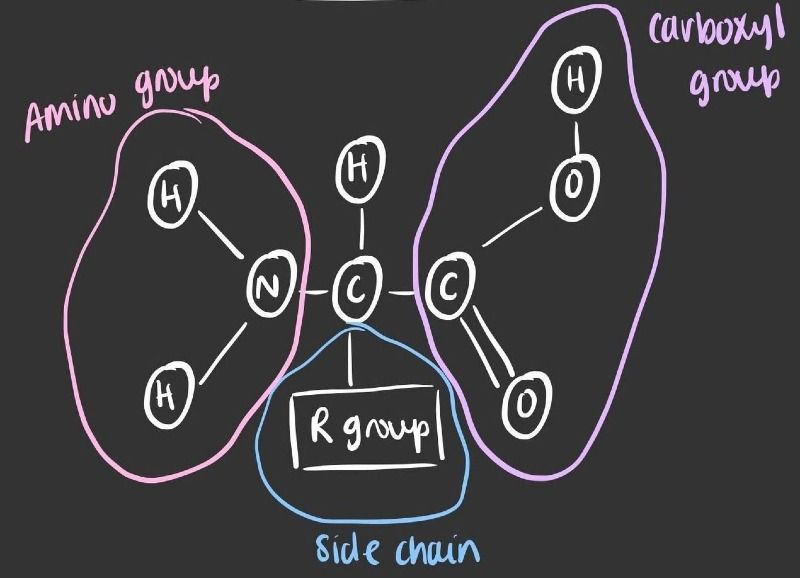
The DNA is made up of building blocks called nucleic acids. It is composed of a phosphate group, deoxyribose sugar and a nitrogenous base. Once these three components are bonded together we have a structure known as a nucleotide. Let's look at this diagram of the structure of a nucleotide. One nucleotide will bind to another nucleotide to form a bond known as the phosphodiester bond.
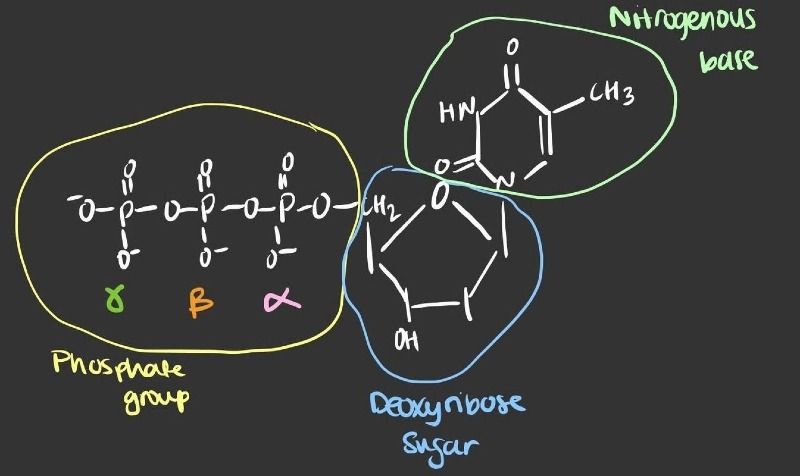
The main difference and the most important to note when understanding the Hershey-Chase experiment is that proteins contain sulfur while DNA contains phosphorus. Keep this in mind!
Now that we understood the differences between proteins and DNA, let's get back to the experiment. So, Hershey and Chase utilized the previously discovered information about bacteriophages. A bacteriophage is a virus that infects bacteria by injecting its DNA into the bacterial cell, the bacteriophage is composed of a protein shell that encapsulates its DNA. Before we see the mechanism in which the bacteriophage infects a bacterial cell, let's look at the structure of the phages.
Note: this is the wildly known structure of the bacteriophage but there are other structures as well.
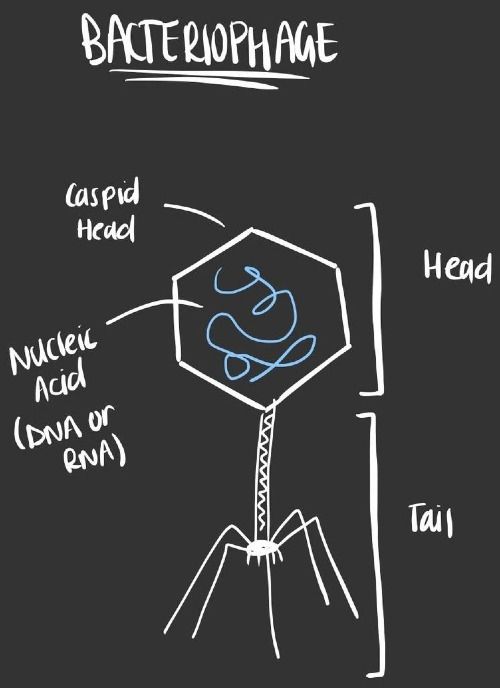
One last concept to grasp before connecting all the dots is isotopes. Isotopes are chemical elements that have different structural forms, they can occur naturally or can be produced artificially in labs. Isotopes are considered unstable and very reactive which allows scientists to detect them using radiation.
Now let's connect all these concepts and understand the Hershey-Chase Experiment. We have proteins and we have DNA, we don't know which holds the genetic material. But we know the differences between them: one contains sulfur while the other contains phosphorus. So, we use bacteriophages that can inject their genetic material into host bacterial cells to determine which is it. To have an easier identification we use isotopes of sulfur and phosphorus.
In more technical words, what Hershey and Chase did is that they infected bacterial cells with radioactive isotopes sulfur and phosphorus, in separate samples. Based on the structure of the bacteriophages, the shell is made up of protein and the inside contains the DNA. Previous experimentation concluded that the phage does not inject the outer coat (protein) into the host cells. So, in one sample they added radioactive sulfur labeled bacteriophages (S35) while in the other sample they added radioactive phosphorus labeled bacteriophages (P32). The samples were then placed into a blender to remove the attached phages on the surface of the host bacterial cells without disrupting the bacterial cells. Then, the samples were centrifuged and the pellet was inspected for radioactivity. One sample showed high radioactivity for P32 in the pellet which is found in the DNA, thus concluding that DNA is what holds the genetic material.
Check this diagram below for a visual representation of the experiment.
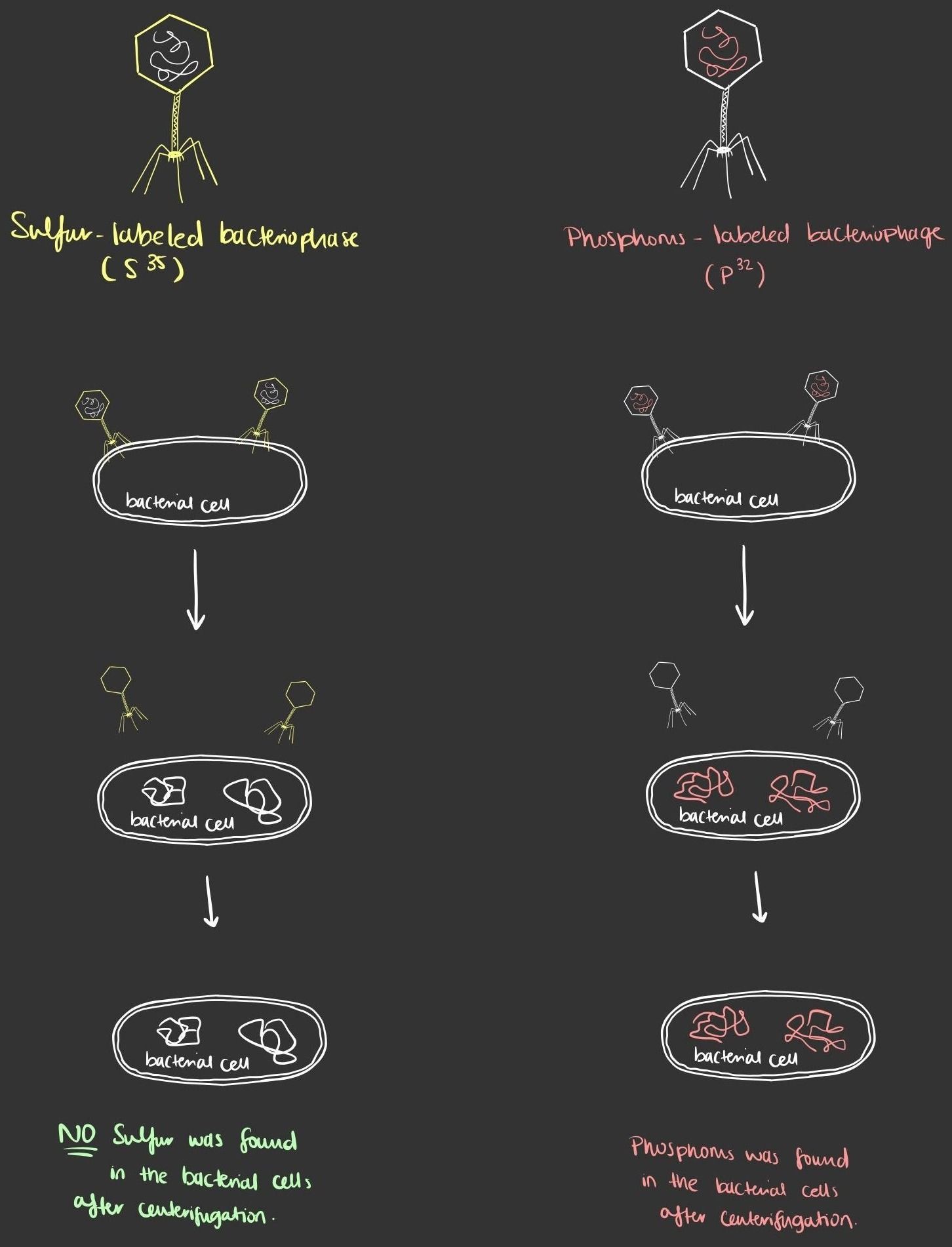
Note: Hershey and Chase were not the first scientists to experiment however they are the ones who verified that DNA is what holds genetic information. As in 1944 Avery MacLoed and McCarty suggested that DNA might be the structure that holds the genetic material.
DNA the thing that makes us unique
Now that we know for sure that DNA is what holds our genetic material, let's take a closer look on what the DNA is. We discussed briefly what the DNA stands for and that it is composed of a phosphate group, a deoxyribose sugar and a nitrogenous base that bond together to form a nucleotide. And the most basic information when describing the DNA is that it is double stranded, helical and anti parallel.
There are four nitrogenous bases that make 4 different nucleotides which are Adenosine (A), Thymine (T), Cytosine (C) and Guanine (G). These four bases are also categorized into two groups: purines and pyrimidines. As long as you are a biology student this information will keep surfacing to you. Purines have a double ring and include Adenine and Guanine while pyrimidines have a single ring and include Thymine and Cytosine (Uracil if we are mentioning RNA).
Now let us go a bit deeper in the structure of the DNA, see how and where different components bind.
A phosphate group and deoxyribose sugar attach together via an Ester bond which is a covalent bond.
A deoxyribose sugar and a nitrogenous base is attached together via a bond known as the Glycosidic bond which is considered a fragile bond. It is also referred to as a nucleoside, since it lacks the phosphate group.
This diagram shows a visual illustration to what has been discussed.
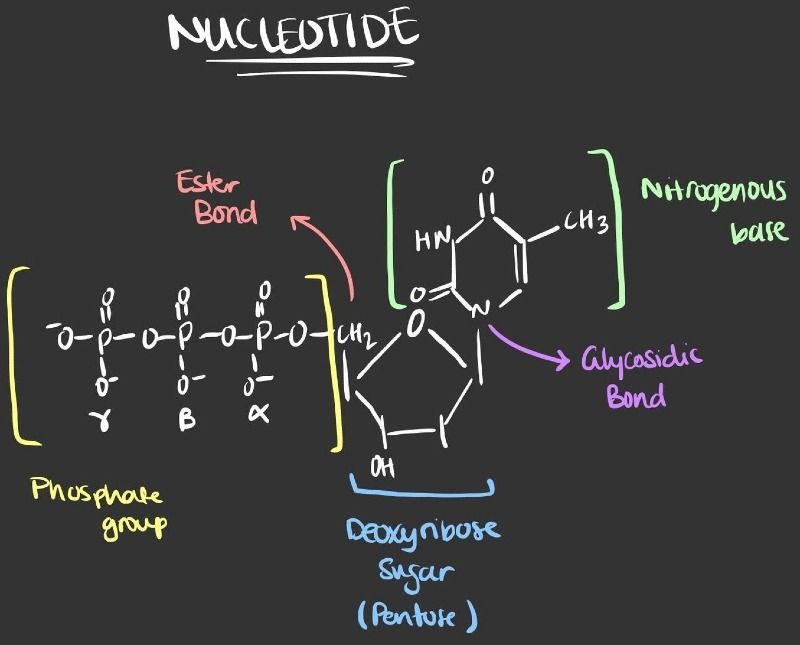
Note: a phosphate group is composed of three phosphates an alpha, beta and a gamma. This information is crucial to understand specific restriction enzyme modification and in what way the nucleotide is incorporated in the DNA strand.
In order to have a DNA strand, nucleotides must bond together to form a chain. One of the most known characteristic of DNA that we continuously repeat is that it has a sugar-phosphate backbone, so let us understand what does that mean.
As mentioned, a free nucleotide has three phosphates (also referred to as a triphosphate nucleotide) an alpha which bonds to deoxyribose sugar, a beta and a gamma. When one nucleotide bonds to another nucleotide like many other chemical reaction, it requires energy (this reaction is also known as an endergonic reaction). Good thing that we have extra phosphates to spare. The two phosphates (beta and gamma) will be cleaved providing enough energy for the bond to occur. So, the remained alpha phosphate will be part of the DNA strand.
Keep in mind! that a free nucleotide and a bonded nucleotide are NOT the same, one has more phosphates that the other!
The phosphodiester bond occurs between the 3' OH of the first nucleotide and the 5' phosphate of the second nucleotide. So, it is a sugar bonded to phosphate and a sugar bonded to phosphate and so on.... As a shortcut we just say a sugar-phosphate backbone.
I know that the 5' and 3' might be confusing and intimidating but you are better and smarter. Just know that it is a way to establish the directions of the DNA. The 5' always refers that the phosphate is free while the 3' always refers that the OH is free. Let's look at this diagram that explains why it is 5' and 3' not any other numbers.
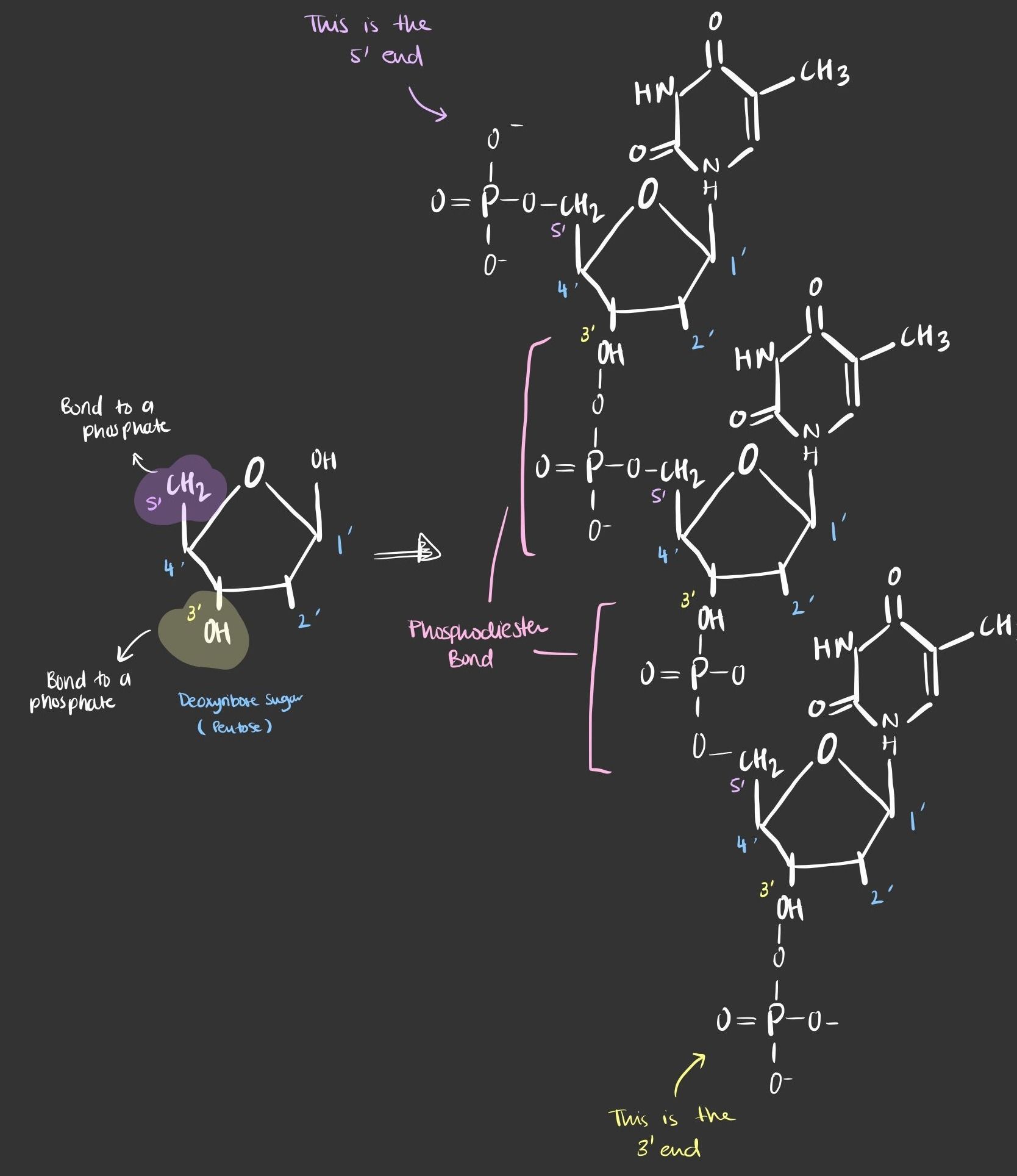
Now that we covered that and have a deeper understanding about the sugar-phosphate backbone, let us look at the nitrogenous bases and discuss the double strands of the DNA.
We have two groups of nitrogenous bases: purines and pyrimidines. Remember that Adenine and Guanine are purines while Thymine and Cytosine are pyrimidines. So, let us understand the mechanism behind the double stranded DNA.
Structurally, the DNA has a sugar-phosphate backbone with the nitrogenous bases protruding and the double strand depends on the bond that occurs between the nitrogenous bases of the separate strands. But how does that happen? Well, there is an important rule to understand regarding the DNA double strands.
Chargaff's Rules of DNA
This rule is simple and straightforward. Edwin Chargaff states that the amount of Guanine is equal to Cytosine and the amount of Adenine and is equal to Thymine. In other other words, the ratio of purines to pyrimidines is 1:1. So, a purine will always bind to a pyrimidine and based on Chargaff's rules, Adenine binds with Thymine and Guanine binds to Cytosine.
So, [A+T] : [G+C].
Watson & Crick
These scientists were awarded the Nobel prize in medicine in 1962, but why? We know the most known characteristics of DNA is that it's helical and double stranded. Well, in the 50s scientists weren't so sure and were desperately experimenting to unravel the structure of the DNA. Much credit goes to Rosalin Franklin's research and experimentation, who through the use of X-ray diffraction of DNA allowed for an easier identification of the DNA structure. Watson and Crick along with other scientists gathered information from previous research to further study their theories and successfully construct the 3D structure of the DNA.
Now that we covered all these basics, lets us move on to the juicy details.
